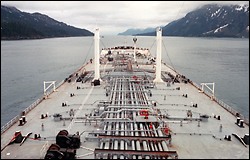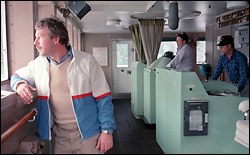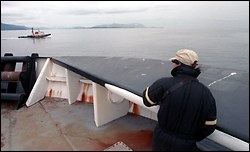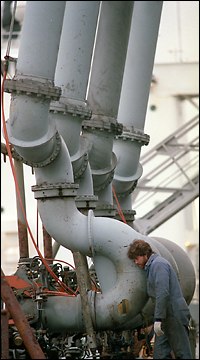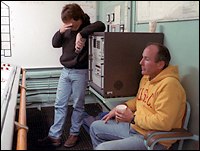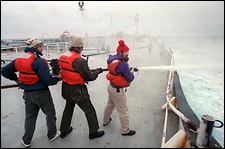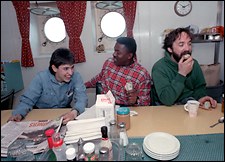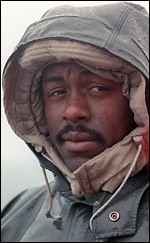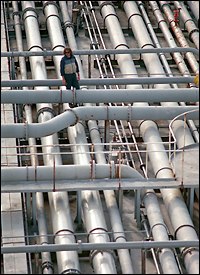 |
 |
 |
| Your account | Today's news index | Weather | Traffic | Movies | Restaurants | Today's events | ||||||||
|
November 12, 1989
The Human Factor
As the tanker passes by Bligh Reef, the underwater rock that ripped open the bowels of the Exxon Valdez, a seaman stands on the bow looking out for icebergs and small boats. This is critical duty: This ship is as long as three football fields, and its stopping distances are measured not in feet, but in miles. The tanker's radar doesn't pick up everything in the water, and visibility for officers in the bridge, 700 feet behind the bow, is partially blocked by the massive deck.
Suddenly, in the middle of a conversation with a visitor on the
bow, the 31-year-old lookout blurts a confession:
Alerted to that handicap, the visitor volunteers that he sees a fishing vessel approaching. The lookout thanks him, and reports the boat to the bridge over his two-way radio. "I don't pick up things as quickly as other people do," the lookout says. "I'm not really concerned about it. Just nervous, maybe." Three days later, as the ship nears the end of its voyage, in the waters north of Puget Sound, a different seaman stands watch on the bow. With the naked eye, he sees vessels seemingly before they appear on the horizon. "It's just experience," he says. How can it be that one day the bow watchman has impaired eyesight, while his counterpart on another day has eagle eyes that pierce the ocean mist?
One answer lies in the Coast Guard's rules for licensing
merchant seamen, rules that don't require regular physical checkups or
practical exams.
The crew of the Arco Anchorage was reorganized last year, with two positions cut. Before the cutback, the crewman with double vision was an entry-level wiper, confined to cleaning up after mechanics in the engine room. Today, he is called upon to work both in the engine room and as a lookout on deck. The crew of the Arco Anchorage usually numbers 25, including four stewards in the kitchen. Crew members say this is a thin line of defense against fatigue on an 883-foot ship that just 25 years ago would have been the largest vessel in the world.
Coast Guard records show that human error contributes to as
many as eight of every 10 accidents involving commercial ships, and
fatigue is a big factor.
The Matsukaze captain, hoping to get rest for himself and other crew members, ordered the second mate to man the bridge alone with no lookout as the ship sailed into the strait around midnight. The second mate fell asleep, and the tanker plowed up on the beach 17 miles west of Port Angeles. There was no spill, thanks to the ship's double-layered bottom, but a Japanese maritime safety agency reprimanded the skipper and suspended the second mate for a month. Nowhere is fatigue worse than on the tankers that ply the waters between Valdez and the refineries of Puget Sound, veteran mariners say. One voyage from Valdez to Washington's Cherry Point - half of the round trip this tanker makes 22 times a year — gives a layman a picture of a steel beehive where workers are on the move around the clock. ICE, WIND, WAVES In winter, the route to Washington state through the Gulf of Alaska is especially grueling. Men and women on these ships are faced with 100-mph winds, sea swells the size of five-story buildings, and numbing cold that can encase the deck in ice.
Even in summer, the ship's main deck is often covered by waves.
The fog is sometimes so thick that officers on the bridge can't see the
bow.
The crew's schedule calls for loading and unloading the tanker every four days. Ninety-hour workweeks are common. Sleep is taken in four-hour snatches. The human line against disasters is a thin one, yet the Coast Guard says it can be even thinner. The Coast Guard certificate for this ship would allow as few as 18 officers and crew members on the Arco Anchorage, not counting cooks and kitchen stewards. That's three fewer than the ship now carries.
Robert Lawlor, the tanker's skipper, says he wouldn't sail with
a crew that small. He acknowledges that Arco requested the reduction
but says there would be "a lot of hell-raising" if the Coast Guard
minimum were implemented. Others in the crew and in the industry agree.
Arco Marine Inc. President Jerry Aspland says no further cuts are planned. But Arco has been much more cautious about making crew cutbacks than other companies. Last year, the Exxon Corp. ordered its ships to reduce overtime in engine rooms, hoping to bolster its case for smaller crews, according to internal memorandums. When the Exxon Valdez went aground, it carried a crew of only 20 on a ship 75 percent larger than the Arco Anchorage. And the Coast Guard had certified the Exxon Valdez to operate with only 15 crew members. WHY SMALLER CREWS? Why has the Coast Guard approved the lower manning levels? Some proffered explanations:
• Competition. Coast Guard Rear Adm. Clyde Robbins, chief of
West Coast operations and overseer of the Exxon Valdez cleanup, says
U.S. concern about foreign competition is one of the driving forces
behind allowing crew cutbacks. At current manning levels, U.S. tankers
are twice as costly to operate as foreign vessels. And experiments in
Japan and Europe call for using only a dozen crew members, all
officers, on tankers.
The entry-level kitchen hand on the Arco Anchorage averages nearly $30,000 a year including overtime. The skipper earns more than $90,000 a year, and the ship's other top officers pull in $60,000 to $85,000. And each ship must pay yearly wages to nearly two crews, because the officers get 5 1/2 months off and crew members get 4 1/2 months off each year. • Automation. Modern equipment allows tankers to operate safely with smaller crews, says Arthur McKenzie, an independent consultant with 50 years in the tanker industry. McKenzie argues that if people cause most accidents on ships, it stands to reason that up to a limit, "the fewer the people that you have, the fewer the casualties."
Proof, he says, is that there are fewer mishaps today than 30
years ago, when tankers had crews twice as large. But others argue that
the safety record reflects better navigation and cargo-handling
equipment mandated by international treaties, and that the record could
be even better with bigger crews.
The rules lay out factors the Coast Guard can consider in determining the minimum size of crews. Those are the ship's size, the routes it travels, the types of cargo it carries, its equipment and automation. • Poor judgment. Deschamps, the retired Puget Sound ship pilot, argues that the Coast Guard has focused too narrowly on ways to reduce crew sizes without doing studies of the effects on maintenance and safety. The first study of that kind was started last year and won't be done until next year, says Charles Bookman, director of the Marine Board of the National Research Council, which is conducting the study under the auspices of the Coast Guard. "There has been a lot of work done on how to bring crew levels down," Bookman says. "But looking at the implications for safety? There is very little data available."
According to an independent expert who asked not to be
identified, the Coast Guard has operated "on a seat-of-the-pants
basis, where you reorganize the crew a bit, take one or two people off
the ship, and see how it goes."
"If you are going to work people all day long, you are looking for trouble," he says. "People have to be sharp. It is amazing how quickly things can happen on a ship." CREWS UNDER THE GUN Just how quickly things can happen was demonstrated by an accident four years ago on this very tanker. The Arco Anchorage maneuvered too far inland at Port Angeles, nudging its hull on the bottom of the bay. In a split second, with no warning, the tanker's bottom cracked, spilling 239,000 gallons of oil — the largest spill in Washington state history. Pilot error was blamed. A visit to the 16-year-old tanker shows that equipment is no guarantee against disaster. The Arco Anchorage is respected as a well-run ship, but it is fitted with a hodgepodge of modern and outdated equipment.
On one hand, its radar can spot most vessels the poor-sighted
lookout misses. But the ship's steam engines are an echo of the past,
and its hull is a thin, single layer of steel, about 1 1/2 inches
thick, that won't prevent a spill even in a soft grounding such as that
at Port Angeles.
Loaded, the tanker is like an iceberg, with three-quarters of its hull hidden underwater even in the calmest seas. It can be ripped open by deep rocks visible only on nautical charts. Stopping it is tougher than braking a locomotive. Fully loaded and traveling at the speeds that are common in Washington's confined waters, the Arco Anchorage would take at least a mile, perhaps several miles, to stop in an emergency. While the ship is braking with the propeller in full reverse, the helmsman would find the vessel almost impossible to steer. And navigation is only one of a myriad of perils on tankers. Crude oil and other products carried on tankers are highly flammable and explosive. Tankers are better protected against fires than they were a decade ago because the oil is sealed in oxygen-free tanks. But even with those improvements, there were 55 fires and explosions aboard tankers in this country alone in the first eight years of this decade, Coast Guard records show. Tankers have detonated like bombs and rained crude oil down from the sky as the result of ignition sources as tiny as the static electricity emitted by a stream of water sprayed inside a tank to clean it. When the tanker Hillyer Brown ran aground in Alaska in 1973, the captain didn't report the accident for 11 hours; he said he feared the radio transmission would ignite the fumes from 42,000 gallons of gasoline surrounding the ship. "Your life is at stake here," says Arco Anchorage crewman Norm Grush." It's got safety features, but it's still a bomb." Also extremely dangerous are the deadly fumes of the crude oil. Crew members descend into the ship's innards for regular maintenance and inspections. Although rules call for tanks to be cleaned and ventilated beforehand, crew members have been quickly and silently asphyxiated and poisoned by their cargo. Sometimes it happens on high ladders and sometimes in the maze of a ship's bottom, but the affects of being "gassed" are usually the same: a little dizziness, a tingling sensation and then, darkness. Even tanks thought to be clean aren't necessarily safe. In 1987 at the Cherry Point dock north of Bellingham, three crewmen of the tanker Concho passed out while mopping up after the ship's tanks had been scrubbed and ventilated for three days. The crewmen were lucky to be alive; one managed to hook his belt on stairs he was climbing just before he blacked out. Otherwise, he would have fallen several stories to his death. Crew members who escape quick death from fumes must worry about another, long-term danger: cancer. A study released this summer by the National Cancer Institute and the Coast Guard indicated a greater-than-normal incidence of four different cancers among 1,760 Coast Guard inspectors who crawled around in the bellies of tankers between 1942 and 1970. The study said the cancers could be related to the chemicals the inspectors encountered while inspecting ships and barges. Getting hurt or sick on one of these ships is not a good idea. The "doctor" is the captain and his nurses are the mates. If they can't handle the problem, evacuation is required. But a ship tossing in 40-foot waves and 100-mph winds is not a place where a helicopter can land or even hover. "It's a fact of life if you are badly injured out here, you will die," says chief engineer Paul Preziose. WINTRY 'HURRICANES' Tanker crew members don't spend much time talking about medical emergencies. Their favorite topic, like nearly everyone else's, is the weather. But the weather in the Gulf of Alaska is not quite like the weather anywhere else. Arco Anchorage crew members recall how last winter, their ship hunkered through 100-mph winds in temperatures of 90 below zero, with the seas raging 40 feet into the air. "You know you are in trouble when the waves start breaking over the bridge," jokes one veteran crewman. The bridge is five stories above the main deck. "Down in the Gulf of Mexico they call it a hurricane. Up here, it's just an average day," says crewman Grush. Even in a 40-mph wind, waves crash over the deck and crew members stuff their survival suits under the outside edge of their mattresses so they will be wedged against the wall while they sleep. Even a huge tanker rolls in these waves. When a tanker is weighed down with oil, only 16 1/2 feet separates the ocean from the ship's deck. The tanker becomes part submarine in a storm, as waves and heavy spray cover the 2-acre main deck. The deck is closed while a loaded tanker is out in the wind because a crew member walking there would be swept overboard. Sometimes the spray freezes. In winter, ships have arrived in Valdez carrying so much ice on the deck that baseball bats and axes are required to free the steel cables for docking. The waters of the North Pacific are so cold that a man in a survival suit will often die before being rescued. The crew practices lifeboat drills regularly, but chief engineer Preziose says: "If you have to hit the lifeboats up here in the North Pacific, you're dead." WHO'S ON THE CREW Why are ships operated in this madness? Because of the country's insatiable demand for oil, say ship owners and crew members. The Trans-Alaska Pipeline and the refineries of Washington state operate round-the-clock. The ships are a crucial link in the delivery system, and the oil companies are loath to shut down the flow because of weather. It takes brave men and women to ride this giant oil can in these violent waters. Many are Washington state residents, but they come to the tankers from all over the nation. On this voyage of the Arco Anchorage, they range in age from 26 to 53. Most officers and some crew members are college graduates, including a third assistant engineer who has degree in mechanical engineering and a cook with a degree in history. There is only one woman on this trip, not a regular member of the crew but a 20-year-old engine-room cadet. Sometimes several women are aboard. The oldest crew member is the boatswain, Jim Pollard, who is in charge of the non-officer deck crew. He's tantamount to a drill sergeant, both in rank and personality. In his 30 years on tankers, Pollard has sailed through hurricanes and an earthquake. He has a fearless attitude toward the sea and a salty contempt for environmentalists and members of Congress, or anyone else who would tamper with his right to transport oil. "Evidently they want to get in the oil business or something, always telling us what to do," he says. "All this nitpicking. Pollution control. Environmentalists. Ecology. It's Big Brother." The youngest crew member is Troy Selph. Like many other tanker crew members, he worries about his future at sea. He's studying to take an exam that would make him an officer because he expects that automated ships may someday carry nothing but officers. A side effect of reducing crew sizes is that ships no longer have jobs for trainees, and the pool of experienced seamen worldwide is shrinking. Erik Kruse, an official with a Norwegian shipping company, says training programs for seafarers are inadequate throughout the world and quality officers are hard to find. In a speech months before the Exxon Valdez spill, he predicted that the shortage would contribute to an increase in groundings and collisions. Crew members such as Selph say cutbacks aren't likely while the public focuses on the Exxon Valdez accident and while some ships still lack automated equipment. But the tanker crew members worry about their job security once the furor over the Exxon Valdez spill dies down. "When they start cutting crews," says crewman Barry York, "you never know where they are going to stop." SHIP OF IRONIES A tanker crew is divided between officers and non-officers. It is also divided between the engine-room staff, whose members rarely emerge from lower decks, and the deck crew, whose job is navigating the ship and maintaining equipment that isn't part of the power plant. The skipper and chief mate oversee the deck crew; the chief engineer is lord below deck. The crew lives in a five-story structure near the rear of the ship. All crew members have their own rooms, and officers have individual bathrooms and showers. The skipper and chief engineer have three-room suites equipped with personal computers. The ship is air-conditioned and makes 60 tons of fresh water a day, more than enough for its boilers, so there is no limit on the duration of showers. Except there isn't time for long showers on a thinly manned tanker. Life on board is full of such ironies. Most crew members say they feel free on the open ocean, but they are confined to a ship. Boredom is a problem, but excitement is not something people want out here. On the far northern oceans, in the eternal light of summer and darkness of winter, the only way sailors keep track of time is by meals and four-hour watches. Food is ample and alcohol forbidden. Each person has an assigned place at the table. Some tankers have swimming pools, but not this one. Officers and crew members eat in separate rooms and watch movies in separate lounges. X-rated movies were eliminated after a female officer complained to company officials. 'NEVER SIT DOWN' The man who enforces these rules and is responsible for everything that happens on the ship is the skipper — in this case, Robert Lawlor, a square-jawed, level-eyed son of a Massachusetts fire chief. Lawlor, 46, has a reputation for being fair but not the least bit reluctant to share his opinions forcefully. His 23 years at sea began in the military-school atmosphere of an East Coast maritime academy, and after 14 years as a ship's master, he continues to value discipline and authority. One symbol of his authority is a chair on the bridge in which he rarely sits. No one else is allowed to sit there. A good captain has a reason for every rule, and Lawlor is no exception. When the second mate on the Japanese tanker Matsukaze dozed off last year, he was sitting in the captain's chair. "You have to be alert up here," Lawlor says, standing on the bridge. "You have to be on your toes. Never sit down. If you did, you'd be fired. There's too much at stake. "I'd hate to say how many people I've fired in my career." The captain is the law on a ship. A statute says he can confine a troublesome crew member to quarters on a diet of water and 1,000 calories a day. Lawlor says he wouldn't think of doing it, given the professional quality of his crew. Lawlor respects and admires his crews. He doesn't admire the tug escorts that are a requirement in Prince William Sound since the Exxon Valdez accident. The tugs' job is to rescue broken-down tankers that might drift into the rocks, but they are slower than the Arco Anchorage. "These tugs can't do more than 13 1/2 knots (nautical miles an hour). They are the lousiest tugs on the West Coast as far as speed is concerned," he says. Lawlor resents the delay because his ship costs $48 a minute to operate, and margins of profit in the oil business aren't what they used to be. He is also worried about the way the tugs are battered by waves as they try to keep up. He wonders what will happen in the gales of winter. Lawlor concludes that the people who made the new rules for Prince William Sound don't know the seas. Lawlor knows these waters like a veteran cab driver knows a city's streets. "If I screw up, or the pilot screws up, I'm done," he says. "There is no margin of error in this business." DRAINING DUTY Work on a tanker is divided into four operations: loading oil, sailing with loaded tanks, unloading oil and sailing back with unloaded tanks. Life is different during each operation, but everything is run with a tight fist on a tight schedule. When the ship is sailing unloaded, that is the time for cleaning tanks and topside maintenance because the deck isn't submerged. When the ship is loaded, that is a time for paperwork. When the ship is loading and unloading, that is a time for round-the-clock vigilance. It's a period that leaves some key crew members exhausted, and is a topic to which the Coast Guard is paying close attention in its study on cuts in crew sizes. As the Arco Anchorage takes on its load at Valdez, chief mate Jeff Portillo's schedule reads like this: a watch at 4 a.m.; a nap at 11 a.m.; up again at 1 p.m. for docking and loading; a nap at 10 p.m.; and up again at 3 a.m. to oversee the topping of the tanks. He'll get another four-hour nap, then assume command of the bridge as the ship is on the final leg of its voyage out of Prince William Sound. "There are times, I won't deny it, when we pull long hours," he says. Too much work and too little sleep are a way of life on tankers. Seaman York, who regularly takes the helm of the ship, says he averages 30 to 50 hours of overtime every week. He says the money is good, but "you get burned out on it." Second assistant engineer Aaron Ragasa worked 40 hours straight during a shipyard overhaul. When the vessel got under way shortly after that, the chief mate stood his watch to give him a rest. Crew members depend on the overtime, but tanker duties such as loading were not designed for sleepy workers. Since the Valdez terminal opened in August 1977, there have been about 400 spills — an average of 33 a year. That figure includes the most insignificant spills (even a bucket tipped over), however, and most have been small ones. There are several ways to spill oil during loading, including overfilling the tanks and bursting pipes and O-rings. It doesn't take long to blow it. When the tanks on the Arco Anchorage are being filled at a maximum rate, oil is pouring on board at a rate of 1,100 gallons a second. The only way to stop the flow is from shore, and it takes 7 1/2 seconds to shut the valves. The hardest part of loading is at the end when the tanks are topped off. That's also when crew members are most tired. Oil pouring into the ship is distributed to 13 tanks by pipes and valves operated by the chief mate in a control room on the first deck. Safety is always a factor, but money is on the line at this stage of the game. The second mate, Harry Wilson, is on deck with crew members who use electronic dipstick tapes to monitor the level of liquid in the sealed tanks. The tapes beep differently in oil and water. That's important. As much as 84,000 gallons of water will have leached out of the crude oil by the end of the trip, a worthless cargo that displaces $34,000 worth of oil. The water content must be estimated at the start of the trip, so the ship owner doesn't lose money. More importantly, the ship must be loaded to a mark on the outside of the hull, known as the load line, which is certified by the Coast Guard. A loaded ship is illegal if it rides below the load line. But for every inch it rides above the load line, it carries $30,000 less oil for the owner. When the ship is full, it has the smell of money. Its load of 35.5 million gallons of Alaskan crude will provide enough gasoline to power 29,000 cars for a year, with enough left over for 9 million gallons of heating fuel, 2.5 million gallons of diesel fuel and 2.5 million gallons of jet fuel. And there will still be 4.6 million gallons for plastics and petrochemicals, and 706,000 gallons for lubricants and specialized oils. But before the tanker can sail, there is one more procedure: Two independent auditors must come aboard to verify the size of the load for the pipeline company and the ship's owner. Nobody blindly trusts anybody in the oil business. Yet the American people have long been expected to trust the oil and tanker companies and the federal agencies that regulate them. That trust went aground with the Exxon Valdez. The crew of the Arco Anchorage knows this, and there is a sober, almost apologetic sense of duty on board as the tanker crawls away from the dock at Valdez. "We weren't so much in the limelight until this Exxon Valdez incident came up," says crewman Ragasa. "It almost gives you the feeling of waiting for another mishap to happen." WHY THE ARCO ANCHORAGE? Seattle Times staff reporter Eric Nalder and photographer Craig Fujii rode the Arco Anchorage tanker in May from Valdez, Alaska, to Cherry Point, near Ferndale in Whatcom County. The opportunity was fortuitous: Atlantic Richfield was the only oil company willing to allow news-media representatives on its ships, and it so happens that the Arco Anchorage is the most frequent tanker visitor to Washington state waters. Notably, it is also the ship involved in the largest oil spill in the state's history, spilling 239,000 gallons of crude into the waters off Port Angeles in December 1985. The Times paid all living expenses of Nalder and Fujii during the five-day trip.
|
|
||||||||||||||||||||||||||||||||||||||||||||||||||||||||||||||
seattletimes.com home
Home delivery
| Contact us
| Search archive
| Site map
| Low-graphic
NWclassifieds
| NWsource
| Advertising info
| The Seattle Times Company
